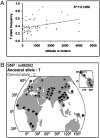EGLN1 involvement in high-altitude adaptation revealed through genetic analysis of extreme constitution types defined in Ayurveda
- PMID: 20956315
- PMCID: PMC2973881
- DOI: 10.1073/pnas.1006108107
EGLN1 involvement in high-altitude adaptation revealed through genetic analysis of extreme constitution types defined in Ayurveda
Abstract
It is being realized that identification of subgroups within normal controls corresponding to contrasting disease susceptibility is likely to lead to more effective predictive marker discovery. We have previously used the Ayurvedic concept of Prakriti, which relates to phenotypic differences in normal individuals, including response to external environment as well as susceptibility to diseases, to explore molecular differences between three contrasting Prakriti types: Vata, Pitta, and Kapha. EGLN1 was one among 251 differentially expressed genes between the Prakriti types. In the present study, we report a link between high-altitude adaptation and common variations rs479200 (C/T) and rs480902 (T/C) in the EGLN1 gene. Furthermore, the TT genotype of rs479200, which was more frequent in Kapha types and correlated with higher expression of EGLN1, was associated with patients suffering from high-altitude pulmonary edema, whereas it was present at a significantly lower frequency in Pitta and nearly absent in natives of high altitude. Analysis of Human Genome Diversity Panel-Centre d'Etude du Polymorphisme Humain (HGDP-CEPH) and Indian Genome Variation Consortium panels showed that disparate genetic lineages at high altitudes share the same ancestral allele (T) of rs480902 that is overrepresented in Pitta and positively correlated with altitude globally (P < 0.001), including in India. Thus, EGLN1 polymorphisms are associated with high-altitude adaptation, and a genotype rare in highlanders but overrepresented in a subgroup of normal lowlanders discernable by Ayurveda may confer increased risk for high-altitude pulmonary edema.
Conflict of interest statement
Conflict of interest statement: S.A., M.A.Q.P., B.P., and M.M. are the inventors and have filed patent application no. 1336DEL2010 in India. There are no implications of this patent application on the publication of the manuscript, because the provisional patent application has already been filed. S.N., P.J., P.K.S., S.G., A.A., T.S., and The Indian Genome Variation Consortium have been acknowledged for contributing to the invention but do not fulfill the criteria of inventorship.
Figures




References
-
- Sharma PV. Caraka Samhita. Varanasi, India: Chaukhamba Orientalia; 2000.
-
- Semenza GL. Regulation of oxygen homeostasis by hypoxia-inducible factor 1. Physiology (Bethesda) 2009;24:97–106. - PubMed
-
- Indian Genome Variation Consortium Genetic landscape of the people of India: A canvas for disease gene exploration. J Genet. 2008;87:3–20. - PubMed
-
- Cann HM, et al. A human genome diversity cell line panel. Science. 2002;296:261–262. - PubMed
Publication types
MeSH terms
Substances
LinkOut - more resources
Full Text Sources
Other Literature Sources

